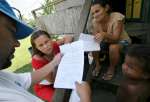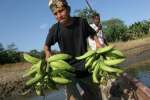- Text size
 |
|  |
|  |
| 
- Français
UNHCR joins aid effort for victims of devastating floods in Colombia
News Stories, 30 December 2010

BOGOTÁ, December 30 (UNHCR) – The UN refugee agency is stepping up efforts to provide emergency assistance to thousands of Colombians affected by exceptionally heavy rains that have caused floods, washed out roads and sparked widespread displacement.
President Juan Manuel Santos has called the flooding "the worst natural catastrophe in the history of Colombia". Government estimates put the number of people affected at more than two million and it has predicted that assistance to victims and the cost of rebuilding infrastructure could exceed US$ 5 billion.
Hardest hit has been the north of country where dozens of towns remain under water. Thousands of people are living in shelters, and others have moved to less affected areas.
Responding to the government's appeal for international assistance, the UN refugee agency – which runs an operation to assist more than three million people displaced by violence – began distributing emergency aid in affected areas two weeks ago. The agency is working with local and regional authorities as well as with the Colombian Red Cross.
"We found people isolated in the hills, in places where the roads have been destroyed, and their children were hungry," says Marlene Mesa, a UNHCR staff member who took part in an aid distribution in the area of Cantagallo, south of the province of Bolivar on the Caribbean Coast.
During his visit to Colombia earlier this month, the UN High Commissioner for Refugees António Guterres expressed his sympathy for those caught up in the flooding. "I would like to express the full solidarity of UNHCR and the UN in Colombia at this moment of intense pain," he said. UNHCR has since committed additional funds to help to over 35,000 people and is signing an agreement with the Colombian Red Cross.
Mattresses, hammocks, mosquito nets, blankets, as well as shelter materials are being delivered to hard hit areas, including the departments of Atlantico, Bolivar, Cordoba and La Guajira in the north; Santander and Norte de Santander in the East; and Antioquia and Choco in the west.
Many of those displaced by the flooding had only recently begun to rebuild their lives after being forced from their homes by the violence of illegal armed groups. Those uprooted by violence in Colombia often end up living in vulnerable areas – close to rivers, in unstable terrain, or on hillsides where there is the risk of mudslides. For them, the challenges of again starting their lives once the flood waters recede will be enormous.
By Gustavo Valdivieso in Bogotá







































